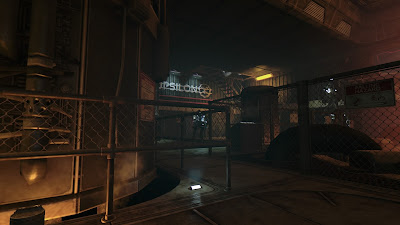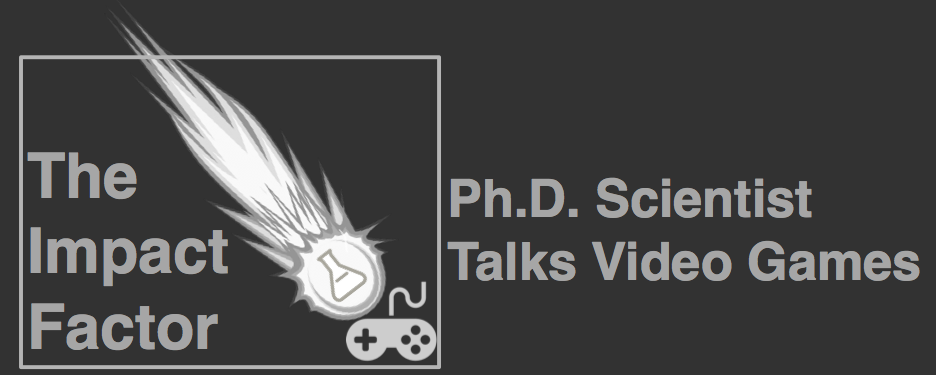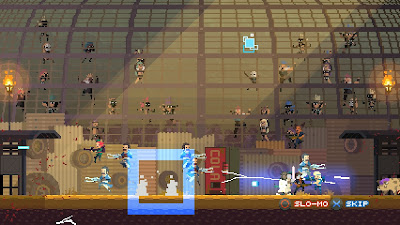The Dead Sea
Review
SOMA,
Frictional Games (PS4)
Abstract: SOMA sets a new high watermark for narrative in games. Frictional’s
newest explorer slash survival horror title is a thought provoking, immersive
masterpiece. Smart level and monster design keep the player actively engaged
with the heady experience and maintain a great sense of momentum throughout. SOMA is deeply unnerving, content to
keep you up at night rather than jump out of a dark corner to scare you. SOMA is a phenomenal experience and
easily one of 2015’s best.
SOMA is a game that asks big questions.
Questions about identity and the contextualization of life and death. As an
academic, these are questions I’ve faced before in my studies. But never have
they been presented so thoughtfully and completely in a video game. SOMA is a catalyst of thought, a vehicle
for introspection, and is one of the year’s best games.
Frictional
Games set the bar high for themselves after their genre-redefining horror game,
Amnesia: The Dark Descent. The 2010
hit brought horror back to its roots, stripping the power of the player against
the game’s terrifying monsters. Amnesia:
The Dark Descent kicked off a new era of horror games in which fans of the
genre, myself included, are still reaping the rewards. To say that Frictional
Games topped themselves with SOMA
would be an understatement. While decidedly less “scary” than its predecessor, SOMA is still a deeply unsettling title
that establishes a new high watermark for narrative in games.
Talking
about SOMA’s story is difficult without
getting deep into spoiler territory, so I’ll avoid any specifics. SOMA is a first-person exploration slash
survival horror game. Yes, the ordering there is correct. You play as Simon
Jarrett. After a brief prologue, Simon finds himself in a small locked room of
what looks to be a derelict space station. His cool blue-gray metal surroundings
contain evidence of catastrophic tragedy: blood on the floor, flickering
lights, busted windows, the echoing groans of substantial structural damage,
and the scratching of distant movement. The player soon learns they are located
at Pathos-II, a research facility at the bottom of the Atlantic Ocean.
From that point forward your quest is to discover where you are, when you are,
and what’s happened to Pathos-II. Simon is a fairly blank slate, used as a
cipher to take in this mysterious (and horrifying) new world. SOMA is about darkness and decay. In
your journey to understand Pathos-II and the work being done there, the player
is forced to ask questions about themselves and about reality. SOMA is a psychological horror
experience, tapping into some of humanity’s deepest-rooted fears. Occasionally,
and unfortunately, Simon will butt in and audibly ask the questions the player
has already been thinking. But usually, SOMA
allows the deafening silence of the alien ocean floor to act as your mental
parchment. SOMA’s story is phenomenal
and gripping. It’s environmental narrative and storytelling of the highest
caliber. You’ll just have to trust me on this one.
While ostensibly
a “survival horror” game, SOMA isn’t
scary in the way most previous games in the genre have tried to be. SOMA isn’t about screams or shrieks or
jump scares or soiled underwear. SOMA is
about laying awake in your bed after you stop playing for the night, unable to
go to sleep because your mind is racing with the “what if’s” and the “could it
be’s” of the game’s world. Most horror games revolve around the fear of dying,
or the repulsion towards blood and gore. In SOMA,
your fear revolves around the questions of “what is life” and “what is death.”
Fear is derived from your location and the circumstances of your world. That’s
not to say the game is without it’s blood chilling, palm-wetting moments of
sheer terror. The game’s ending in particular was one of the most tense,
fear-inducing moments I’ve ever experienced in a piece of media. The
implication of my situation was crushingly dark. My stomach was in my throat
(and that’s not just because I had the stomach flu during the majority of my
playthrough). SOMA is a game that
will scare you, just not in the way you’re used to.
SOMA succeeds extraordinarily at
creating atmosphere. The game wouldn’t have worked without it, as environmental
horror is at the crux of your experience. Pathos-II and the ocean surrounding
it are perfectly realized. SOMA is
shockingly immersive. The game’s many locations are detail-rich, visually
diverse, and filled with interactble objects. SOMA utilizes a physics-based world interaction mechanic. For the
most part, everything around you can be picked up, rotated, dropped or thrown.
Documents can be picked up and read, computer terminals can be used to scour
audio logs or e-mails. This system allows the player to interact naturally with
their world—as if you yourself were present. These interactions aren’t perfect,
though, as many objects are static (even some that are visually similar the
ones that can be interacted with), which can lead to some player confusion.
It’s a wholly excusable offense, however, as the work required to create “full”
immersion would be astronomical. In the end, the interactability and sound
design and well-thought out visuals synergize to create a fully realized world.
 |
| Gorgeous visuals and a keen attention to detail make SOMA one of the most immersive games I've ever played. |
But what do
you do in the terrific world of SOMA?
Exploration, mostly. Every nook and cranny is filled with interesting reading,
audio logs, and character black boxes that all expand your understanding of the
world. You use your trust Omni-Tool to open doors, turn on power, and for
exposition. When you’re not exploring, you’re given puzzles to solve. I’m happy
to report that SOMA gets puzzles
right. Each and every puzzle you’re tasked with solving felt purposeful. The
puzzles organically fit into your experience. I never got the feeling that a
puzzle was thrown in to slow my progression. Or as a checkpoint that read “need
to solve puzzle to advance.” SOMA’s
puzzles are straightforward, but that doesn’t mean they aren’t engaging or
meaningful. Some of the game’s puzzles are simple on the surface, but dive into
deep physiological and philosophical issues. How to solve them doesn’t cause you to scratch your head, but what you’re doing (really what exactly you’re doing) can lead to some
serious contemplation.
 |
| Reading notes, logging into computers, and accessing blackboxes (above) help to fill in the missing pieces. |
Standing as
an impediment to your exploration are SOMA’s
several monsters. As I mentioned earlier in the review, Amnesia: The Dark Descent brought about a new era of horror games
in which the player is powerless against enemies. The same is true in SOMA. No shotguns or chainsaws or rocket
launchers here. I read concern about the game online, about how even fans of
the genre were getting sick of the gameplay loop of sneaking around and hiding
from monsters. Fair enough. Even though I enjoyed Amnesia, hiding in a cabinet isn’t the most compelling gameplay. Frictional
Games were certainly aware of this issue—it’s almost completely ameliorated by SOMA’s new monster mechanics. SOMA’s enemies are perfect. You’re not just hiding. Each monster you face as a unique
weakness. While you do face your standard monster (you just need to stay out of
sight), others make you play the game in new ways. For example, there’s a
monster that can only see you when you’re looking at it. Getting past it
involves quick spatial reasoning, as you must navigate cramped and often
mazelike areas while looking at the floor. Sometimes with the monster standing
right next to you. Or another that follows you by sound, which allows you to
trick it away from your location by throwing objects around. Each new monster
is a puzzle, an adventure, that keeps you on your toes. As a final quick note,
death comes infrequently in SOMA. The
game achieves the perfect balance of always feeling like you’re about to die, while not actually killing you.
It’s a rare achievement in a horror game. So many struggle to get this balance
right.
 |
| Sometimes you can run. Sometimes you can hide. Sometimes just don't look it in the eye. Scary stuff. |
SOMA’s lingering impact is one of
context. Who you are, what you are defined by, is relative. Life, death, and
everything in between loses meaning without the proper framework. Or, at the
very least, the meaning changes. SOMA
allows the player to experience this change. You find a survey on a computer
terminal at the beginning and end of your time with the game. I answered the
questions honestly both times I took it and man, did my answers change. I
changed.
 |
| It was hard to avoid spoilers because SOMA is so darn exciting. But I assure you this image, like the review, is spoiler free |
A good
sense of momentum propels your towards the game’s conclusion. Each hour of the
roughly 8-10 hour experience builds upon itself. Nothing lingers, except for SOMA’s existential questions. I didn’t
think a game could make me interrogate my thoughts on the level SOMA achieved. SOMA is thought provoking, and sets the bar astronomically high for
narrative experiences in the future. A must play.
SOMA
5/5




















